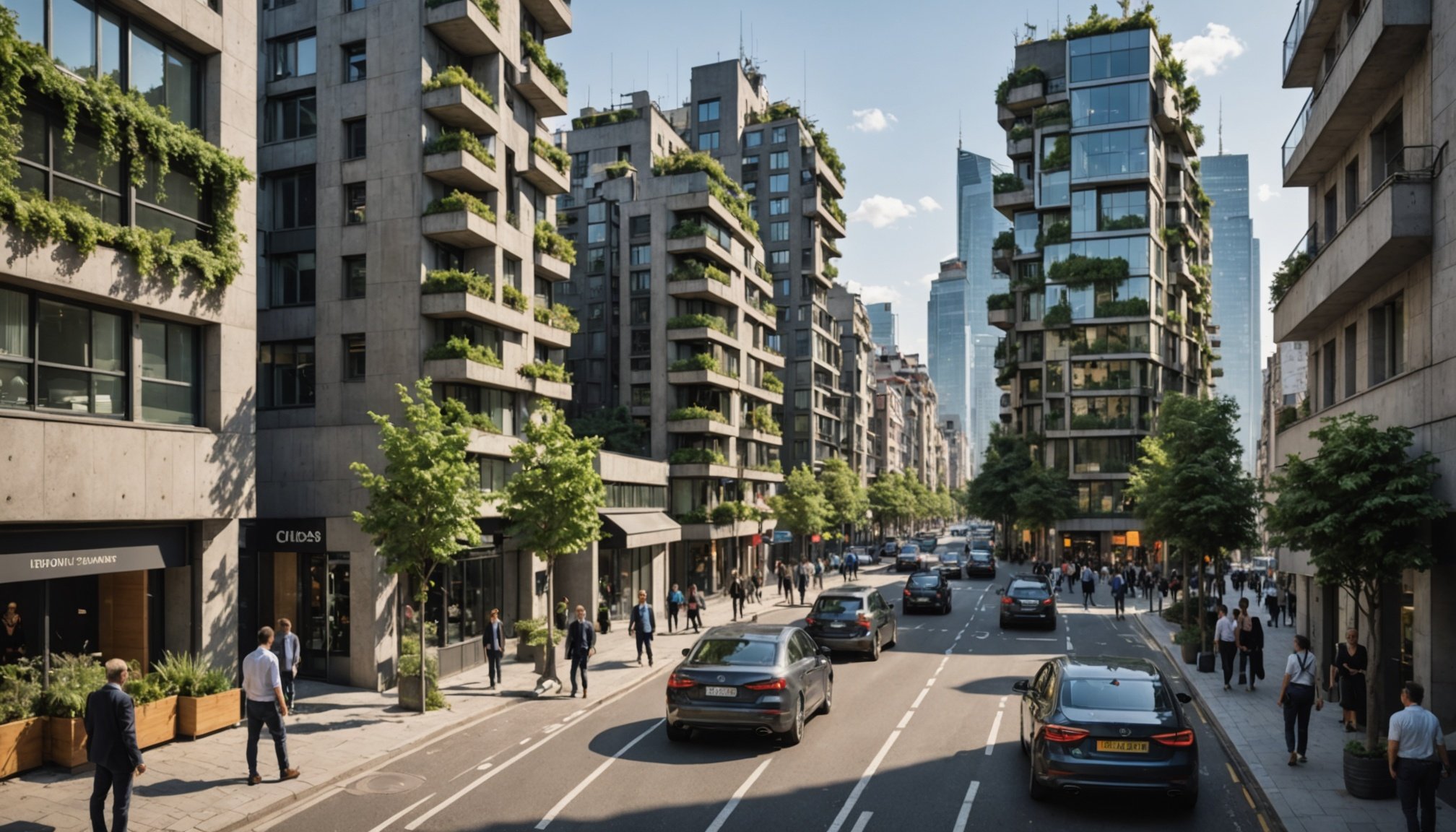Transforming Urban Landscapes: The Role of AI in Boosting Sustainable City Planning and Smart Development
As the world hurtles towards an increasingly urbanized future, with projections suggesting that by 2050, two out of three people will be living in or around cities, the need for sustainable and smart city planning has never been more pressing. Artificial Intelligence (AI) is emerging as a pivotal tool in this endeavor, revolutionizing the way cities are planned, managed, and developed.
Enhancing Urban Planning with AI
Urban planning is a complex and multifaceted field that involves managing various aspects of city life, from transportation and energy to public safety and environmental sustainability. AI is transforming this landscape by providing urban planners with powerful tools to make data-driven decisions.
Topic to read : Unleashing creativity: a comprehensive guide to Huion drawing tablets
Auditing Built Environment Features
Researchers from Virginia Tech’s College of Natural Resources and Environment have demonstrated how large language models (LLMs) like ChatGPT and Google’s Gemini can enhance the auditing of built environment features. These models can detect elements such as benches, sidewalks, trees, and streetlights, which are crucial for assessing walkability and safety in urban areas[2].
For instance, a study published in The Professional Geographer showed that LLMs accurately identified features like trees, bicycles, roads, and vegetation with over 95% success. However, there were some limitations, particularly with features like streetlights, sidewalks, and vehicles, which had success rates between 70 to 85%[2].
Also read : Mastering video creation: the ultimate commercial maker guide
Improving Data Quality
One of the significant takeaways from this research is the importance of data quality. Kee Moon Jang, the lead author of the study, emphasized that “the better the data quality, the better the LLMs perform.” This has led researchers to focus on creating high-quality synthetic training data to improve these models. Despite the geographical biases in the training data, which can affect performance in smaller towns, the potential of LLMs in urban planning is vast[2].
Smart City Management and AI
Smart cities are at the forefront of integrating AI, the Internet of Things (IoT), and data analytics to optimize resources, improve infrastructure, and enhance the quality of life for residents.
Real-Time Data Analytics
AI improves smart city management by analyzing real-time data, automating service delivery, and enhancing public communication. For example, AI voice APIs, such as those provided by Respeecher, are making cities more inclusive by offering accessible communication solutions. These APIs transform how citizens interact with urban infrastructure, providing real-time information and personalized voice services[4].
Here are some ways AI is enhancing smart city management:
- Public Transportation: AI voice APIs can be integrated into public transportation systems to provide real-time announcements and updates, making the system more accessible and user-friendly.
- Emergency Response: AI-driven voice technologies can be used in emergency response systems, ensuring that critical information is communicated quickly and effectively.
- Information Kiosks: Accessible information kiosks powered by AI voice APIs can help citizens navigate urban services independently, regardless of their physical abilities[4].
Sustainable Development and Environmental Impact
AI is also playing a crucial role in sustainable urban development by addressing environmental challenges.
Urban Heat Islands and Tree Canopy
Google Research is using AI to help cities mitigate the effects of urban heat islands. By analyzing satellite and aerial imagery, AI tools can identify areas where planting trees or using highly reflective surfaces can reduce surface temperatures. For instance, the City of Austin has used Google’s Environmental Insights Explorer to prioritize planting trees in vulnerable areas and even to place bus shelters to increase shade[5].
Here are some key initiatives:
- Heat Resilience Tool: This tool helps cities understand how to reduce surface temperatures through targeted interventions.
- Tree Canopy Analysis: AI combines with aerial imagery to assess current tree coverage and plan urban forestry initiatives.
- Cool Roofs: AI recommends the use of highly reflective surfaces to reduce heat absorption in urban areas[5].
Traffic Management and Emissions Reduction
AI is also being used to optimize traffic management, which is a significant contributor to greenhouse gas emissions. Google’s Project Green Light uses AI to make recommendations for city engineers to optimize existing traffic lights and reduce emissions from stop-and-go traffic. Since its first pilot in 2021, the project has expanded to over a dozen cities worldwide, including Rio de Janeiro, Seattle, and Boston[5].
Here are some benefits of AI in traffic management:
- Optimized Traffic Lights: AI adjusts traffic light timings to reduce congestion and emissions.
- Fuel-Efficient Routes: Google Maps uses AI to suggest routes that reduce fuel consumption by avoiding hills, traffic, and inconsistent speeds[5].
Inclusivity and Public Services
Inclusivity is a fundamental aspect of urban planning, and AI is helping to ensure that all citizens can benefit from smart city developments.
Accessible Communication
AI voice APIs are crucial in making public services more accessible. For people with visual impairments, literacy challenges, or other disabilities, these APIs provide essential tools for interacting with public services independently. Here are some ways AI is enhancing inclusivity:
- Public Announcements: AI-driven voice technologies can provide real-time announcements in public transportation systems.
- Information Kiosks: Accessible information kiosks powered by AI voice APIs help citizens navigate urban services.
- Emergency Systems: AI-driven voice technologies can be used in emergency response systems to ensure critical information is communicated effectively[4].
Practical Insights and Actionable Advice
For urban planners and policymakers looking to integrate AI into their strategies, here are some practical insights and actionable advice:
Focus on Data Quality
- Ensure that the data used to train AI models is of high quality and diverse to avoid geographical biases.
- Invest in creating synthetic training data to improve model performance[2].
Collaborate with Experts
- Work with researchers, academics, and industry experts to develop and implement AI tools.
- Collaborate with local communities to understand their needs and ensure that AI solutions are tailored to their requirements[5].
Prioritize Inclusivity
- Ensure that AI solutions are designed to be inclusive, providing equal access to urban services for all citizens.
- Integrate AI voice APIs and other accessible technologies into public services to enhance inclusivity[4].
AI is revolutionizing urban planning and smart city development by providing powerful tools for data-driven decision making, enhancing public services, and promoting sustainability. As cities continue to grow and evolve, the integration of AI will be crucial in creating more livable, sustainable, and inclusive urban environments.
Here is a summary of the key points discussed:
| Area of Impact | AI Applications | Benefits |
|---|---|---|
| Urban Planning | Auditing built environment features | Improved walkability and safety assessments |
| Smart City Management | Real-time data analytics, AI voice APIs | Enhanced public communication, automated service delivery |
| Sustainable Development | Urban heat island mitigation, tree canopy analysis | Reduced surface temperatures, increased tree coverage |
| Traffic Management | Optimized traffic lights, fuel-efficient routes | Reduced emissions, improved traffic flow |
| Inclusivity | Accessible communication, public announcements | Equal access to urban services for all citizens |
In the words of Kee Moon Jang, “The development of a user-friendly tool can significantly contribute to the productivity of local governments by reducing the time and cost involved in built environment audits.” As we move forward, it is clear that AI will be a cornerstone in the transformation of urban landscapes, making cities smarter, more sustainable, and more inclusive for all.
Table: Key AI Applications in Urban Planning and Smart City Development
| Application | Description | Benefits |
|---|---|---|
| Built Environment Auditing | Using LLMs to detect features like benches, sidewalks, trees, and streetlights | Improved walkability and safety assessments |
| AI Voice APIs | Integrating voice technologies into public services for real-time information and personalized voice services | Enhanced public communication, increased inclusivity |
| Urban Heat Island Mitigation | Analyzing satellite and aerial imagery to reduce surface temperatures | Reduced heat-related issues, improved urban forestry |
| Traffic Management | Optimizing traffic lights and suggesting fuel-efficient routes | Reduced emissions, improved traffic flow |
| Data Analytics | Analyzing real-time data to automate service delivery and enhance public communication | Improved efficiency in public services, better decision making |
| Tree Canopy Analysis | Assessing current tree coverage to plan urban forestry initiatives | Increased tree coverage, improved environmental sustainability |
| Emergency Response Systems | Using AI-driven voice technologies for critical information dissemination | Enhanced public safety, timely response to emergencies |
Detailed Bullet Point List: How AI is Enhancing Urban Planning and Smart City Development
-
Enhanced Data Collection and Analysis:
-
AI can collect and analyze vast amounts of data in real-time, providing insights that can inform urban planning decisions.
-
Examples include using satellite and aerial imagery to assess built environment features and urban heat islands.
-
Improved Public Services:
-
AI voice APIs can enhance public communication by providing real-time information and personalized voice services.
-
This includes public transportation announcements, accessible information kiosks, and emergency response systems.
-
Sustainable Urban Development:
-
AI tools can help cities mitigate urban heat islands by identifying areas for tree planting and cool roof installations.
-
AI can also optimize traffic lights to reduce emissions and suggest fuel-efficient routes.
-
Inclusive Urban Planning:
-
AI-driven solutions can ensure that all citizens have equal access to urban services, regardless of their physical abilities.
-
This includes integrating AI voice APIs into public services to make them more accessible.
-
Decision Making and Policy Development:
-
AI can provide urban planners with data-driven insights to make informed decisions.
-
This includes using AI to analyze the impact of different policy interventions on urban environments.
-
Collaboration and Community Engagement:
-
AI can facilitate collaboration between urban planners, researchers, and local communities.
-
This ensures that AI solutions are tailored to the specific needs of each community.
-
Environmental Sustainability:
-
AI can help cities adapt to environmental challenges such as climate change.
-
Examples include using AI to map buildings and track changes in urban environments over time.
-
Public Safety and Emergency Response:
-
AI can enhance public safety by providing timely and effective emergency response systems.
-
This includes using AI-driven voice technologies to disseminate critical information during emergencies.
By leveraging these capabilities, AI is not only transforming urban landscapes but also ensuring that cities become more sustainable, inclusive, and livable for all residents.











